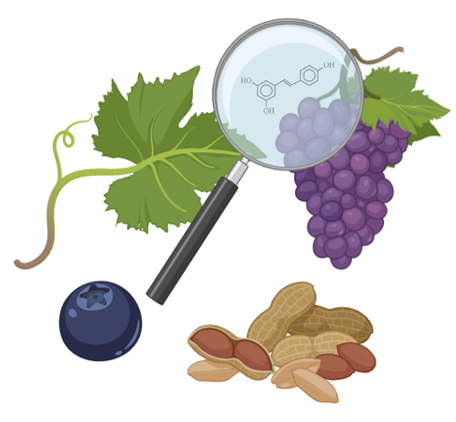Do all bioactive compounds act as prebiotics?
By Daniel Vazquez Maldonado
Certainly, the ability of microorganisms to use mostly any substrate to survive, from inorganic to organic sources, leads to the topic of this blog, mostly due to the broad range of metabolic activities that microorganisms may have. Who hasn’t heard about microorganisms that may even use radiation as a source of energy?
So, when it comes to gut health, and how the microorganisms in our gut metabolize specific substrates that are in our food, there are benefits to this process, like stimulating the segregation of IgA, the enhancement of the immune system, production of small chain fatty acids (SFAs), among others, it’s interesting to investigate more about all the compounds that microorganisms may use.
But let’s start defining what a bioactive compound is. Bioactive compounds are a wide range of substances from different sources like fungi, food, algae, bacteria or even animal sources. They also may have diverse classifications, depending on their structure, like carotenoids, alkaloids, polysaccharides, terpenoids or polyphenols, or even a wider classification as other researchers have established like macro and micronutrients, phytonutrients and gut regulators.
Nonetheless, the definition of bioactive compounds is still unclear, the main concept falls on compounds with or without nutritional value that exert an effect on living organisms’ cells, or tissues that lead to health benefits.
Bioactive compounds may also be vitamins, some of which are produced by gut bacteria, such as folate, riboflavin, or vitamin K. However, for a bioactive compound to be classified as a prebiotic, the health benefit must come by the selective use by host microorganisms.
What are the health benefits of bioactive compounds?
The main health benefits that bioactive compounds have demonstrated are cardioprotective, antioxidant, anti-inflammatory, lipid-regulating, glucose metabolism, and gut homeostasis. This is achieved by regulating gene expression, interleukin release, immune cell differentiation, antioxidant activity, and regulating cell pathways, therefore influencing cell function, structure, or behaviour.
That’s why in this context, bioactive compounds are of particular interest to study, because apart of getting a direct benefit in our health from its consumption, it would be better if additionally, they contribute to maintain a healthy gut microbiota.
Which bioactive compounds may act as prebiotics?
The most important characteristic for a bioactive compound to act as a prebiotic is the selective use by host microorganisms, thus the main structures of the bioactive compound must be able to be utilized by certain microorganisms, just as β 2,1 and 2,6 linkages found in agave fructans that may be fermented by Lactobacillus and Bifidobacterium.
That’s why, for novel bioactive compounds that are prebiotic candidates, it’s important to know which microorganisms have the genes to metabolize the bioactive compound, and the metabolic pathway(s) involved, its biochemical structure, and also the type of metabolites that can be produced.
In this sense, bioactive compounds like polyphenols, found in some foods like grapes and mushrooms, are metabolized by gut bacteria, e.g. Lactiplantibacillus plantarum that produce active metabolites and stimulate bacteria like Akkermansia muciniphila or Faecalibacterium prausnitzii with potential benefits for human health.
What are the future perspectives for bioactive-prebiotic compounds?
Certainly, the study of bioactive compounds and their prebiotic effect is becoming relevant in the gut microbiome field. Many studies are being held in order not just to know the microorganisms that are stimulated, but also their mechanisms of action. For instance, a review by Gouda et. al. established the metabolic pathways for the synthesis of bioactive compounds such as lutein and astaxanthin by algae. These pathways are described, in addition to analyzing beneficial prebiotic effects e.g. antioxidant and anti-inflammatory activity.
Moreover, other studies focused on the way of delivery for bioactive compounds with prebiotics, and probiotics, looking for a better health outcome by maintaining the biological activity and prebiotic effect are being done, like the ones analyzed by Misra et al., were the improvement of probiotic co-encapsulation with bioactive compounds and also prebiotics proved to be an alternative for developing functional products.
Nonetheless, as in all research and science, more evidence is required. For example, my postgraduate research, which aimed to develop a functional food with probiotic bacteria like Bacillus clausii with resveratrol, led to establishing the conditions for the development of a microencapsulated product by spray drying, with adequate morphological structure, antioxidant activity and B. clausii viability.
Indeed, this line of research is bound to increase my interest in researching more about the effect of bioactive compounds, the development of functional foods and the addition of novel prebiotics.
References
Salinas E, Reyes-Pavón D, Cortes-Perez NG, Torres-Maravilla E, Bitzer-Quintero OK, Langella P, et al. Bioactive Compounds in Food as a Current Therapeutic Approach to Maintain a Healthy Intestinal Epithelium. Microorganisms 2021, Vol 9, Page 1634. 2021 Jul 30 [cited 2024 Mar 10];9(8):1634. Available from: https://www.mdpi.com/2076-2607/9/8/1634/htm
Kussmann M, Abe Cunha DH, Berciano S. Bioactive compounds for human and planetary health. Front Nutr. 2023 [cited 2024 Mar 15];10:1193848. Available from: https://www.ncbi.nlm.nih.gov/pmc/articles/PMC10400358/
Vamanu E, Gatea F. Correlations between Microbiota Bioactivity and Bioavailability of Functional Compounds: A Mini-Review. Biomedicines 2020, Vol 8, Page 39. 2020 Feb 20 [cited 2024 Mar 17];8(2):39. Available from: https://www.mdpi.com/2227-9059/8/2/39/htm
Steve NTI, Hui S. Mushrooms Bioactive as Prebiotics to Modulate Gut Microbiota in Relationships with Causes and Prevention of Liver Diseases (Review). Int J Med Mushrooms. 2020 [cited 2024 Mar 17];22(6):509–19. Available from: https://www.dl.begellhouse.com/journals/708ae68d64b17c52,3d8e7b4f6342518e,5f4ce2f9334338b2.html
Valero-Cases E, Cerdá-Bernad D, Pastor JJ, Frutos MJ. Non-Dairy Fermented Beverages as Potential Carriers to Ensure Probiotics, Prebiotics, and Bioactive Compounds Arrival to the Gut and Their Health Benefits. Nutrients 2020, Vol 12, Page 1666. 2020 Jun 3 [cited 2024 Mar 17];12(6):1666. Available from: https://www.mdpi.com/2072-6643/12/6/1666/htm
Dima C, Assadpour E, Dima S, Jafari SM. Bioavailability and bioaccessibility of food bioactive compounds; overview and assessment by in vitro methods. Compr Rev Food Sci Food Saf. 2020 Nov 1 [cited 2024 Mar 17];19(6):2862–84. Available from: https://pubmed.ncbi.nlm.nih.gov/33337033/
Misra S, Pandey P, Mishra HN. Novel approaches for co-encapsulation of probiotic bacteria with bioactive compounds, their health benefits and functional food product development: A review. Trends Food Sci Technol. 2021 Mar 1;109:340–51.


